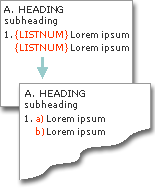The ListNum field inserts a set of numbers anywhere in a paragraph. ListNum fields can be incorporated into numbering from a simple or outline-numbered list.
Syntax
When you view the ListNum field in your document, the syntax looks like this:
{ LISTNUM ["Name"] [Switches] }
Note: A field code tells the field what to show. Field results are what’s shown in the document after having evaluated the field code. To toggle between viewing the field code and the field code results, press Alt+F9.
Instructions
Name
Associates a LISTNUM field with a specific list.
To emulate the AUTONUM, AUTONUMOUT, and AUTONUMLGL fields, use the NumberDefault, OutlineDefault, and LegalDefault names with the LISTNUM field.
Switches
\l
Specifies the level in the list, overriding the default behavior of the field.
\s
Specifies the start-at value for this field. This is always assumed to be an integer.
Example 1
LISTNUM fields were used in this example to generate the numbers (i),(ii), and (iii):
The Borrower shall deliver to the Bank a certificate of its chief financial officer, certifying that (i) no Default has occurred, (ii)the attached financial statements have been prepared in accordance with generally accepted accounting principles, and (iii) the attached certificate correctly sets forth the calculations for determining the ratios specified in Sections 5.08, 5.09, and 5.10.
The first LISTNUM field in the example includes the name and the level switch:
{ LISTNUM NumberDefault \l 6}
Example 2
LISTNUM fields are used in this example to generate the letters that appear on the same lines as the numbers:

Each LISTNUM field in the example includes the name and the level switch:
{ LISTNUM OutlineDefault \l 4}










